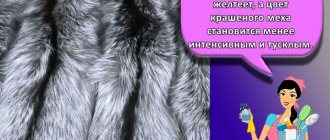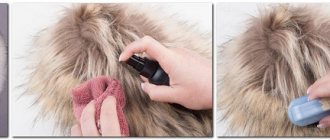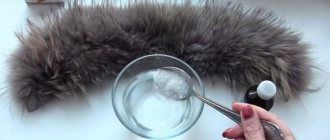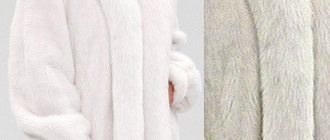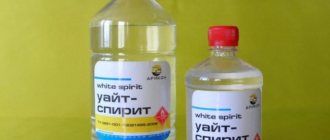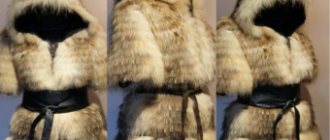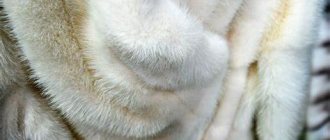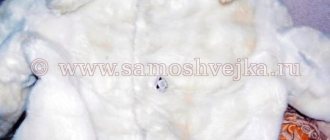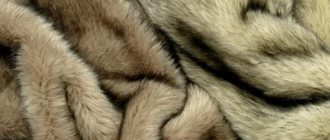Over time, the fur wears out, may fade in places, and lose color saturation. But this is not a reason to send things to the trash bin. After painting, they have a good chance of starting a new life. Ateliers and dry cleaners may convince you that old products will not withstand such exposure, or they may demand a considerable amount for the procedure. We will tell you how to easily and inexpensively dye fur at home.
Where to dye a fur product?
There are several options for resolving the issue of where to send fur for dyeing. They differ in price and range of services offered. Before you decide, check which ones are available in your city.
- If you have problems with clothes, it is customary to contact the atelier. Fur items are no exception: there are special fur studios that you can contact with questions about repairing and dyeing.
- Some dry cleaners not only wash clothes, but also dye fabrics and fur.
- In factories, fur is dyed without fail, but on an industrial scale. Not all factories can be contacted to ask about painting a particular product.
- It is absolutely easy to dye your fur yourself at home.
How can you dye fur?
Manufacturers claim that coloring occurs using complex technology using dyes and oxidizing agents. In fact, this technique is almost no different from dyeing at a hairdresser. It turns out that fur can be successfully updated with regular hair dye. After all, the structure of animal hair is very similar to human hair. The described method is safe for strong inner skin (skin from the underside of the pile), reliable and easy to perform. It is suitable for any type of natural pile.
It is not recommended to repaint new things. Painting is a way to extend the life of a worn item. As for new things, the procedure will only shorten their service life.
It is important to know that you cannot work with finished products (hats, fur coats, collars) without first stretching them. This is necessary in order to have access to the flesh.
Before you begin, you need to check the condition of the flesh. You need to moisten it with water and try to stretch it. If it does not stretch or tear, you can use paint. Otherwise, it's not worth the risk. You can tint the color with a tint hair balm, following the instructions. The bright and fresh shade lasts as long as paint. In this way, you can dye artificial hair, since it is not as durable as real hair, as well as silver fox, arctic fox, rabbit, and mink.
What you need for work
To dye any fur, first of all, you need to buy paint. It is advisable to completely repaint only faded products. If faded or peeling spots appear on your fur coat in some areas, it is better to touch them up with a spray. The main thing is to choose the right shade of aerosol.
Methods for dyeing fur products:
- Spread (by rubbing oxidative paint or acid dye into the fur).
- Spraying, tinting (spraying aerosol paint over the pile).
Tips that will come in handy when dyeing fur:
- the paint should be darker than the original color of the fur product;
- during the dyeing process, do not wet the skin (inner space);
- It is forbidden to repaint new things;
- It is better to tint a large fur coat with an aerosol;
- Suede paint is suitable for painting small faded areas;
- you can do highlighting (dye individual strands);
- It is better to paint with a hair coloring brush;
- You can fix the color with 9% vinegar;
- It is better to dry the product with a hairdryer (if there is a “cold air” function);
- To clean the pile, it is recommended to use a washcloth and dishwashing detergent;
- It is better to protect the skin (inner space) with glycerin.
Instructions for dyeing fur at home
Since the fur is thick and long, you may need 2 packs of paint. This is especially true for the Arctic fox and mink. It is better not to buy the first coloring product you come across, but to prefer proven brands. Having prepared the workplace, you can begin painting using a two-step method.
Stage 1 - preparation
Necessary for removing grease and dust for high-quality and uniform painting.
- Prepare a cleaning solution: soda, salt, washing powder, a teaspoon per liter of water.
- Clean the lint with a brush.
- Rinse under warm running water.
- Leave until dry.
Stage 2 - painting
- Wear protective plastic or rubber gloves on your hands.
- Prepare the coloring mixture according to the instructions.
- Before you start staining, you need to treat the skin with glycerin (you can replace it with any fatty cream). This will prevent the skin from drying out.
- Apply the mixture as quickly as possible, combing the pile in the direction of natural growth.
- Roll up and place in a plastic bag.
- The paint must be kept on for as long as indicated in the instructions. Compliance with the recommendations is mandatory, otherwise you risk spoiling the material.
- Rinse in warm water with any shampoo.
- Treat with any hair balm for shine and silkiness.
- Rinse off all products with warm running water.
- Rinse in warm water with vinegar added: 1 tablespoon per liter of water. You can use any table vinegar.
- Dry gently with a towel.
- Lubricate the inside again with a thin layer of glycerin. Gently knead it.
The drying process should take place under natural conditions - at room temperature, without the use of heaters, hair dryers and air conditioners. Drying time can be up to 3 days depending on the length and thickness of the fur. Speeding up the process can lead to damage to the fibers.
After drying, the product may shrink. To avoid this, pin it to any hard surface with the inside down. For example, push pins or sewing pins to a wooden board.
Blonde and red shades are difficult to cover with any hair dye, no matter how much it costs. Therefore, you can repeat the procedure 2-3 times, especially if you want to get a rich black color.
It’s easiest when you just want to enhance the tone or make it darker. In order to properly dye the fur of an arctic fox, which is white or another light color, at home, you need to very carefully paint the pile down to the very roots and the core itself. This can be done with a regular toothbrush and then combed in different directions with a comb. It is worth keeping in mind that chemical exposure to the skin does not go unnoticed. To change its color with minimal risk, use a regular marker.
When dyeing dark items in lighter colors, you need to be prepared for an unexpected result. Of course, like hair, fur with dark pigment must first be bleached. To avoid surprises, cut a small piece of material and work on it. You can experiment by mixing colors in different proportions to achieve the desired result.
How to prepare fur
You can repaint part of a fur product or the entire thing. The fur needs to be prepared for painting. Before dyeing, it is advisable to separate the fur collar from the main product. If you need to repaint the entire item, it is recommended to tear off the lining. Only clean things are painted. Dirty fur must be cleaned. Before cleaning the wool, it is advisable to lubricate the skin (underside) with glycerin on the reverse side.
You can place the fur coat on a wet sheet (nap side down) and use a beater to knock out dust and dirt from it.
Methods for cleaning fur products:
- a washcloth and soap solution (shampoo, washing powder, liquid soap, dishwashing detergent);
- with a damp cloth and 3% hydrogen peroxide dissolved in water;
- soft brush and solution (soda + 3% hydrogen peroxide + salt + shampoo);
- store-bought fur cleaner (Furasol cleaning spray).
When cleaning, try not to wet the skin. Only the fur is cleaned. When cleaning, it is advisable to place the fur product vertically. After cleaning with detergent, the fur should be wiped with a damp, clean washcloth and then dried with a hair dryer. After drying, clean wool should be combed with a brush.
See also
How long does oil paint take to dry on different surfaces?
What to do if you can't use paint?
The described technique is not suitable for artificial fur, since its structure is not as strong as that of natural fur. Also, if you are afraid of damaging or staining the product, your skin is weak, unreliable, or there are any other reasons to avoid chemical hair products, you can get by with shoe paint for suede, velor and nubuck in cans. This method will cope well with masking burnt areas. According to the instructions, you need to shake the can and apply the substance from a distance of 20 cm. To ensure that the color is evenly distributed over the entire surface, after application the paint can be “smeared” with a napkin.
If you are no longer going to wear clothes with fur and don’t know what to do with it, consider decorating your handbag, headphones and other accessories with stylish, bright and colorful fur inserts.
If you are still not sure whether to paint your product and how exactly to do it, contact a workshop and consult with specialists.
After proper dyeing in compliance with all the rules and instructions, the fur will become as soft and thick as before, and will look completely new!
Over time, natural fur loses its visual appeal - it fades, becomes dull, loses its shine or becomes stained. What to do if a fur coat, hat or coat with a fur collar, which can last for many more years, has become unpresentable in appearance? There is a solution to this problem - you can paint them. This option is also acceptable if you are tired of the item and want to update it. You can entrust the procedure to a professional or try to handle the painting yourself. How to dye fur at home and where is the best place to do it? Which dye to choose?
Causes of color loss
Mink loses color for various reasons. They may be as follows:
- The product fades as a result of prolonged wear.
- The fur coat was stored incorrectly, which is why it lost its strength and attractiveness.
- The fur was dyed poorly. Clothes owners tried to do it themselves or turned to unqualified specialists.
The safest way to dye a product is in a studio where they work with natural fur, or in specialized workshops. There are trusted craftsmen who will repaint a mink coat using professional equipment.
The technologies used will preserve the fur and return the fur coat or collar to its former attractiveness. Products restored in workshops will last for many more years.
Dyeing a mink coat is a rather expensive procedure.
Its cost depends on the following factors:
- dyeing method;
- materials used;
- dye color;
- length and style of the product;
- fur condition.
Typically, the price of color restoration ranges from 10 to 30 thousand rubles.
General rules for dyeing fur
To return the fur to its original color, paint is selected 1 shade darker than the existing one. Light-colored items are painted tone-on-tone. The dyeing process at home can lead to unexpected or unsatisfactory results, so you should only experiment with old furs. Trying to paint a new, expensive item at home just to get a different color is not recommended.
Before the procedure, the selected composition should be tested in an inconspicuous place - this will help minimize the risk. If the shade is acceptable and the fibers have not fallen out or broken, proceed to dyeing the entire product.
Preparation
Before dyeing a mink coat, it must be carefully prepared:
- First of all, you need to carefully tear off the lining.
- Then you need to remove additional accessories from the product - buttons, decorations, etc.
- The villi must be degreased; during use, every hair on the fur coat is covered with a film that will prevent the paint from penetrating. You can take it to the dry cleaner, but since you decided to dye it yourself, you can prepare an alkaline cleaning solution at home. To do this, you need to take regular baking soda, table salt and detergent in equal proportions and dilute with water to a mushy state. Apply the resulting mixture to the fur, making sure that it is distributed evenly. Particular attention should be paid to the elbow bends, sleeve cuffs, collar area, and the area around the buttons - they tend to become more greasy. Then the skin is dried, without the use of auxiliary devices (heaters, hair dryers). When the product is dry, shake it thoroughly and comb it with a clothes brush.
- Everyone knows that hair dye dries out the skin very much. It will have the same effect on a natural fur coat. Dried fur can “break” at bends from the inside, and on the outside, at the break point, it will lose its lint. In order not to end up with a “bald” fur coat, the fur should be lubricated on the inside with greasy cream or Vaseline.
Where to paint and what will be needed for this?
Depending on the size of the product, you can paint it by laying it on a table, the floor, or hanging it on a hanger. Before the procedure, it is necessary to protect work surfaces by covering them with cellophane. Painting is carried out by wearing old clothes or clothes that you don’t mind getting dirty, and protective gloves.
To carry out the procedure yourself at home you will need:
- dye;
- cleaning composition;
- brush or brush;
- comb;
- cellophane;
- glycerol;
- shampoo, hair conditioner;
- table vinegar.
Before painting, the fur must be cleaned, since if there is dirt, the paint may apply unevenly. To do this, use animal shampoo or prepare a cleaning composition yourself:
- dissolve 2 tbsp in 2 liters of water. l. soda and salt with mild liquid soap or dishwashing liquid, adding a few drops of ammonia;
- Mix water, table vinegar and ethyl alcohol in a 1:1:1 ratio.
Before cleaning, the inside must be treated with glycerin or a fatty cream - under the influence of water it can lose its shape and crack. The cleaning composition is applied to the entire fur surface, left for 10–15 minutes and rinsed off with clean water.
What and how can you dye or tint fur?
In order to dye fur, you can use various means. Hair dyes provide long-lasting deep coloring, and their range is so wide that you can find absolutely any shade.
Hair coloring products
Hair coloring products are great for fur because the fibers are very similar to human hair. The closest in structure is mink. You should not skimp on the composition: it should be gentle and durable. When purchasing, you need to take into account that when dyeing long, thick fur, especially black or bright colors, you will need a lot of product, and it may take more than one package. The paint is diluted in accordance with the instructions for use, wearing protective gloves: in a shallow non-metallic container, mix the dye and oxidizing agent until a homogeneous mass is obtained.
The resulting composition is applied to the fur and distributed over the entire surface. If the amount of work is large, it is more convenient to use a brush. For small items, use a special paint brush. To evenly distribute the product over the entire length and not leave unpainted areas, use a comb. The composition is left for a certain time according to the manufacturer’s instructions (about half an hour), then washed off with water. If necessary, the fur is washed with shampoo, then combed and dried.
The fur coat already looks worn, but it’s still a shame to throw it away. To improve its appearance, you can paint it. If you study the information in detail, this process will not be difficult. How to dye fur, what you need for this, how to prepare, is described below.
Sequence of painting in the workshop
Before processing, the specialist examines the fur coat for the condition of the fur, skin, and the strength of the seams. The owner chooses the future color of the product. Experts do not advise choosing bright, unnatural colors: red, blue and the like. These dyes contain toxic substances that can ruin fur and skin.
To restore the color of products, several dyeing methods are used:
- namazny;
- dipping;
- combined.
Experts will advise which method is best to choose. To get a quality product, it is better to use deep coloring rather than tinting.
Well-dyed fur remains soft, the skin does not lose elasticity, and the color is distributed evenly. After painting, the mink coat is completely renewed and its wear life increases.
Preparation for the process
Before painting, the product must be prepared. How to clean fur:
- a teaspoon of dish soap; 2 teaspoons salt; 10 g soda; 5 g of ammonia; liter of water.
The components are made into a homogeneous liquid. Clothes are hung on hangers or placed on the table. Apply the cleanser with a brush and leave for a few minutes. Wash off with running water so that it does not get on the lower part.
What else is suitable for cleaning:
- mix water, vinegar, alcohol in equal proportions; distribute over product, rinse.
Afterwards the item is dried outside or in a ventilated room. Do not hang it next to a stove or radiator.
These methods are suitable for cleaning mink, rabbit, silver fox, arctic fox fur - any natural fur.
Cleaning is necessary to ensure even paint application. Dirt and dust will not allow this to happen.
The leather part of the clothing is treated with ordinary hand cream. It will not dry out or crack.
Caring for fur after dyeing
Fur loves frost; it fluffs up in a special way at negative temperatures. Therefore, it is recommended to first comb the painted product with a thick brush in all directions, then hang it on the balcony or “walk” in frosty weather when the opportunity arises.
Important! It is useless to repaint a collar that is too old; its shabby interior will not withstand the aggressive effects of a chemical dye.
If you decide to tint a short fur coat or vest, after modernization it is not advisable to wear it in wet weather. High-quality paint does not fade, it does not give dirty streaks in the rain. Still, it is better to refrain from such experiments - the Arctic fox turns red and dull from dampness.
It is recommended to comb the painted product with a thick brush.
Types of fur
Useful tips for coloring fur depending on the type:
- White wool is the easiest to dye. Chinchilla and rabbit fur coats are easy to dye. This is done carefully so as not to damage the delicate fur. If the white fibers turn yellow, they are lightened with hydrogen peroxide. Then any color will lie flat. The arctic fox's hair is dense and will take a lot of time and paint. It is easier to work with arctic fox, the paint applies easily, and the color remains for a long time. Dyeing a mink coat is not easy. It is difficult to paint.
- Items made from nutria are easier to paint than mink. It is similar to mink, but lighter. She has three types of hair in thickness and length, so her fur is close-fitting. The painted muskrat turns out pinkish with white spots. After a short time it fades. The fur of a sheared beaver cannot be lightened beautifully. It will turn yellow. It is worth using darker paints to match the original color. It is not easy to dye a mouton fur coat due to its high density. It is necessary to carefully distribute the dye and carefully monitor the uniformity of application. Otherwise you will get stains. When dyeing silver fox fur, the new color is usually given to the longest fibers.
Where do they paint?
Where can you dye a fur coat or fur item:
- In a studio specializing in fur processing. They will repair and paint it there. Some dry cleaners offer a fur dyeing service. They paint in factories, but usually in large quantities. If you wish, you can find a company to dye your fur coat. It’s easy to do it yourself at home.
It is recommended to paint small items or parts of large items yourself. There is a possibility that you won’t be able to make an even, monochromatic color.
Mexican jerboa? You have been deceived, this is the Shanghai leopard!
So, it was decided that a fur coat would not be a pity if something happened, or not a single studio in Moscow where you can dye a mink offers the desired color. Let's paint!
For long-haired products, coloring with regular hair dye is suitable. Of course, the result will be better if the fur coat is dyed a tone darker; if you want to get a light coat from a darker fur coat, then it must first be lightened with hydrogen peroxide. In general, when dyeing natural fur, you need to arm yourself with the rules, just like when dyeing your head - animal hair is very similar in structure to human hair.
Dyeing process
It is recommended to dye any natural fur a couple of shades darker than its natural color. What means to use:
- hair dye; tint shampoo/balm; aerosol paint for suede; spray dyes for fur; clarifier
Bleaching agents damage hair. After bleaching, a fur coat will last less than originally planned. It's worth considering whether drastic changes are needed or whether it should be painted a darker color.
Applying hair dye
Animal fur and human hair are similar in structure. This product is ideal for dyeing fur. Before use, you should test the effect on a small, inconspicuous area of the item. If necessary, first remove yellowness from clothes. After this, they begin painting. High quality ammonia paint is recommended.
How to use hair dye correctly:
- Wear gloves. Dilute the product according to the instructions. Apply to the product with uniform, quick movements. Rub it all over the fur - no stains should remain. Movements must be careful so that the hairs do not break.
- Leave for the time specified in the instructions. Wash in clean warm water with shampoo. For softness and shine, apply hair balm. Wash off with running warm water. Rinse with a solution of vinegar in water. A tablespoon is diluted in a liter of water.
After staining, the cream is applied to the skin again. The item is blotted with a towel and dried. To prevent clothes from shrinking, they are pinned to a hard surface with the fur facing up.
To paint it black, one procedure is not enough. This is done 2-3 times.
You should not do complex dyeing or highlighting of wool yourself. This kind of work should be entrusted to professionals. If you have experience in dyeing your hair this way, you can try:
- apply paint to the ends; wrap in foil and leave for the required time; wash off carefully.
If you dye a natural fur coat at home correctly, it will last for a long time. The color will begin to fade after 7-9 months. After this time, it is recommended to update the color.
Industrial dye for fur coats is almost identical in composition to hair dye.
Aerosol
Suede product is suitable for dyeing part of the product. The ends of the Arctic fox's coat may turn yellow over time. How to spray paint fur:
- spray at a distance of 70 cm from the item; Move the spray all the time so as not to stick the hairs together; After spraying, comb through, then they will not stick together.
There is a special paint for natural fur in the form of an aerosol. A small area is dyed with it, for example, a fur collar. This part should not come into contact with the bag; constant interaction will leave a mark. How to do:
- spray the desired area on a jacket or fur coat; massage for distribution; dry naturally.
You won't be able to paint it a completely different color with a spray. You can enhance the shade, make it richer and deeper.
Other options
You can recolor fur items in the following ways:
- A yellowed mink hat is lightened with the following composition: combine a couple of tablespoons of hydrogen peroxide and 10 drops of ammonia. Wet the ends of the fibers so that the liquid does not get on the skin. You can paint a red fur coat with a manganese solution. It must be concentrated. Apply the solution with a new dish sponge and make sure that the skin does not get wet. Tinting with a tinted shampoo will help make the color deeper and richer. This is true if your fur coat, hat or vest was previously dyed with hair dye. The tint maintains the color to delay the time of the next hair dye application.
- To soften an old fur coat and give it shine, you should use hair balm. This is done after dyeing or mixed with a tint. Finish the staining by rinsing in a vinegar solution. Rabbit fur is dyed at home only in extreme cases with delicate dyes. It is very gentle and thin. Fur inserts on coats are painted carefully so as not to stain the main material. If the fabric allows it, sew a piece of fabric onto the main part with a few stitches. You can wrap a piece of unnecessary fabric and secure it with a pin.
How to dye faux fur with your own hands:
- remove dirt and dust with a cotton pad and shampoo, rinse with water; To update the color, use a toning shampoo; use dye for faux fur, but not for hair; To ensure uniform distribution of color, the item is pulled and fixed; brush along the fibers without missing the fabric; After the required time has passed, wash it, comb the fur, and leave it to dry.
How to lighten arctic fox fur
This method is ideal for bleaching yellow fox clothing or for lightening dark fox. This will require the use of hair bleach or simple hydrogen peroxide. When using lighters, follow the instructions included with them.
Dissolve peroxide tablets in water, apply the solution to the wool and leave for 15 minutes. Do not leave it on for more than a quarter of an hour, as the pile may become thin and brittle.
Rinse and dry. Then it is tinted to your favorite shade. You should not bleach the fur of an arctic fox more than once, otherwise there is a risk of causing irreparable damage to it.
Grandma's recipe
Our grandmothers used this method to bleach yellowed fur when there were no ready-made dyes on sale. Its action is not based on chemical reactions, but in an optical illusion and continues “until the first snow.” Dilute a small amount of blue in warm water, wet the sponge and lightly walk through the pile. The result is visible when it is completely dry.
Express method
Specially formulated fur dyes are available in aerosols for a quick refresh.
.
This can is really easy to use. Keep it at a distance of 20-25 cm and spray one by one on individual threads. Brush your hair periodically to prevent it from sticking together.
Manufacturers position this treatment as tinting. Deep staining cannot be achieved using this method. This is good when you don’t want drastic changes, but rather hide minor flaws. For example, yellowed tips or spots. This can is also convenient for working with a template. The color range of aerosol paints is classic: white, black, shades of brown and gray.
How to care
Proper care to preserve color and newness:
- sometimes comb your hair with a special brush; dry clothes if it’s snowing outside; clean contaminated, worn-out areas in a timely manner; Before storing, remove stains and dust; Use a cover for storage after winter.
Painting a fur product is not a difficult task if you approach the process correctly and follow all the instructions. If the item is badly damaged, you need to dye the entire fur coat, or you are afraid that it won’t work, it is better to contact a studio.
